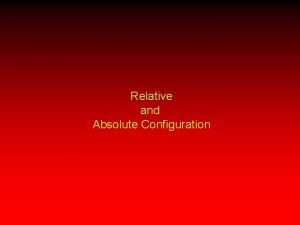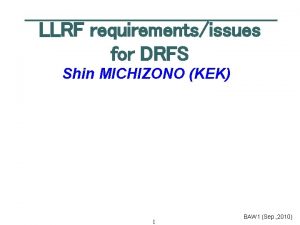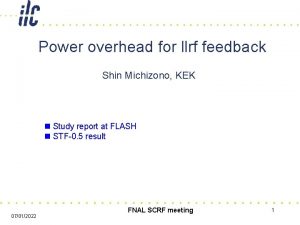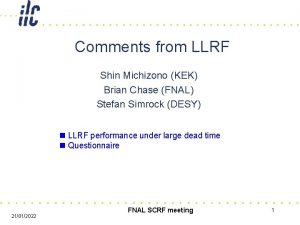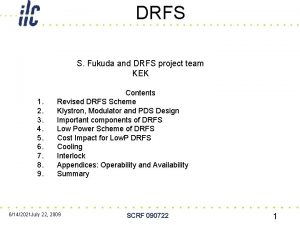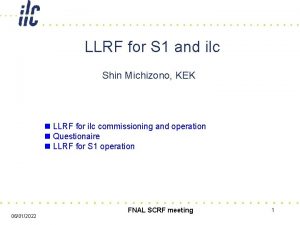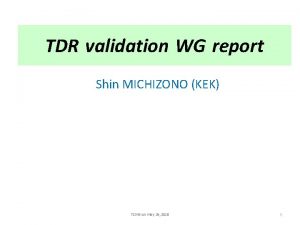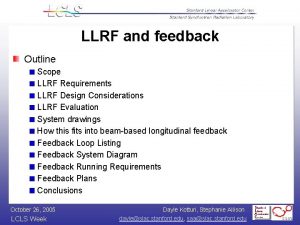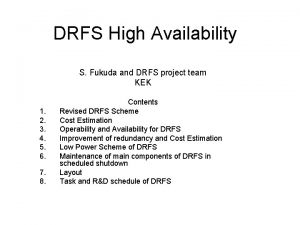DRFS LLRF system configuration Shin MICHIZONO KEK n









- Slides: 9

DRFS LLRF system configuration Shin MICHIZONO KEK n LLRF lack layout for DRFS n DRFS cavity grouping n HLRF requirements n Cavity filling pattern GDE meeting Beijing (Mar. 27, 2010) 1

LLRF lack layout for DRFS 1 baseline unit (26 cavities, 3 cryomodules) p 19 inch rack (total 16 U) is located in every cryo-module (8 or 9 cavities) p. Each FPGA board (FPGA 1 -5) drives a klystron. p. Maximum cable length is <10 m (negligibly short) 21/01/2022 2 Rittal TILC 09 (Apr. 20, 2009)

LLRF lack layout for DRFS (2) Micro-TCA Rittal p. Each FPGA board (FPGA 1 -5) drives a klystron. p 10 ch DACs are used for piezo drivers. p 30 ch downconverters receive rf signals (cavity , forward and reflection power of each cavity) p. Clock generator creates clock and timing signals synchronized with master oscillator. 21/01/2022 3 TILC 09 (Apr. 20, 2009)

DRFS cavity grouping 0 m. A 9 m. A n If different gradient cavities are driven by a klystron, we need more power to operate them (~14% if operate 25&38 MV/m cav. ) n In addition, flatness is only guaranteed when operated the certain beam current. -> In DRFS, we will make cavity grouping and operate at same gradient. 4 LC review (2010/02/12)

HLRF requirements n KEKB injector klystrons (40 MW and 50 MW) are statistically analysed. n Klystrons have 1. 2% (40 MW) and 1% (50 MW) rms HV distribution to reach 40 or 50 MW. n. These correspond to ~3% power distribution with same HV. (P~V^2. 5) n Suppose the cavity distribution is 2. 5 MV/m rms, 770 k. W klystrons can drive 38 MV/m cavities with 15% rf overhead. 5 GDE meeting Beijing (Mar. 27, 2010)

HLRF requirements (2) From the different point of view…. From A. Yamamoto’s presentation n Suppose the cavity max. gradient improve, the operational gradient (-10% of max. quench limit) and 770 k. W klystron yield 31. 9 MV/m (even if we limit the operational gradient to be 35 MV/m) n We propose 770 k. W klystron for DRFS with cavity pairing. 6 GDE meeting Beijing (Mar. 27, 2010)

Cavity filling pattern (1) n DRFS modulators with sag n 8 deg. /% HV n If sag ~10%, 80 deg. Rotation during rf pulse -> phase compensation will be required. n Output will be 20% more in case of 10% sag. n In order to use the rf power efficiently, we propose “Full power filling” scheme. n This is effective to shorten the rf pulse. n Filling is made only phase control. 7 GDE meeting Beijing (Mar. 27, 2010)

Cavity filling pattern (2) Cavity gradient n Shorter rf pulse width is confirmed by simulation. n 15% rf power overhead is assumed. HV sag Power Average RF pulse sag power saving increase 10% 20% 10% 6. 2% 5% 10% 5% 5% n. Full-power filling can compensate the rf power increase by 5% HV sag. Forward power Reflection power 8 GDE meeting Beijing (Mar. 27, 2010)

Summary n u. TCA based llrf system is planed for DRFS. n Cavity grouping will be adopted for higher cavity efficiency. n Nominal 770 k. W klystrons can drive 35 MV/m pair and the good-performance klystrons can drive 38 MV/m pair. n Full-power filling scheme is proposed and will be studied at S 1 -grobal. 9 GDE meeting Beijing (Mar. 27, 2010)




